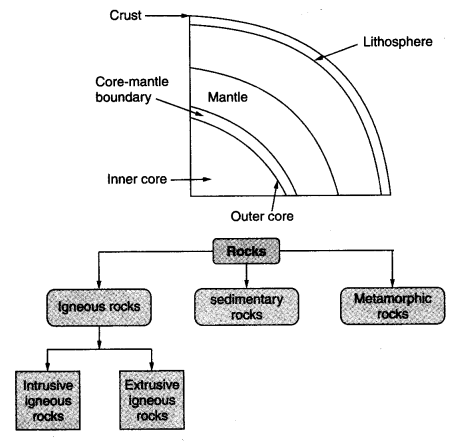Inside Our Earth Class 7 Notes Social Science Geography Chapter 2
What is Earth?
- The earth comprises three layers: crust, mantle and core.
- Constant changes take place inside as well as outside the earth.
What is the Interior of the Earth?
- The earth is made up of three concentric layers-crust, mantle and core.
- The uppermost layer over the earth’s surface is called the crust. It is about 35 km thick on the continental masses and only 5 km thick on the ocean floor. It is made up of silica and alumina and thus called sial.
- The oceanic crust mainly consists of silica and magnesium called sima. Just below the crust is the mantle up to an extent of 2,900 km.
- The innermost layer is the core with a radius of 3,500 km. As it is made of nickel and iron, it is called nife(ni-nickel and fe-ferrous i.e. iron). The central core has a very high temperature and pressure.
Rocks and Minerals
- The earth’s crust is made of various types of rocks. Any natural mass of mineral matter that makes up the earth’s crust is called a rock.
- There are three major types of rocks; igneous rocks, sedimentary rocks and metamorphic rocks.
- When the molten magma cools, it becomes solid. Rocks thus formed are called igneous or primary rocks. They are of two types, extrusive igneous rocks and intrusive igneous rocks.
- Rocks roll down and break into small fragments and these smaller particles are called sediments. These sediments are transported, compressed and hardened to form layers of rocks. These types of rocks are called sedimentary rock.
- Igneous and sedimentary rocks can change into metamorphic rocks under great heat and pressure. The process of transformation of the rock from one to another is called the rock cycle.
- Rocks are made of different minerals. Minerals are naturally occurring substances which have certain physical properties and definite chemical composition.
The earth is constantly undergoing changes inside and outside. Therefore, it is called a dynamic planet.
The earth is made up of several concentric layers. The uppermost layer over the earth is the surface is called the crust. It is the thinnest of all the layers.
The mantle is just beneath the crust.
The innermost layer is the core with a radius of about 3500 km.
The central core has a very high temperature and pressure.
The earth’s crust is made up of several types of rocks.
There are three types of rocks—igneous rocks, sedimentary rocks and metamorphic rocks.
Igneous rocks are also called primary rocks. They are of two types—intrusive rocks and extrusive rocks.
Extrusive igneous rocks have a very fine-grained structure. For example, basalt.
Intrusive igneous rocks are formed deep inside the earth. Granite is an example of this rock.
Sedimentary rocks are formed by the sediments, which are small fragments of rocks. For example, sandstone is made from grains of sand.
Igneous and sedimentary rocks can change into metamorphic rocks under great heat and pressure. For example, clay changes into slate and limestone into marble.
Hard rocks are used for making roads, houses and buildings.
One type of rock changes to another type under certain conditions in a cyclic manner. This process of transformation of the rock from one to another is known as the rock cycle.
Rocks are made up of various minerals.
Minerals are naturally occurring substances which have certain physical properties and definite chemical composition. Minerals are very essential for human beings.

Crust: The uppermost layer over the earth’s surface. It is very thin.
Soal: The continental mass of the crust consisting of silica and alumina is called sial (si-silica and al-alumina).
Sima: The oceanic crust mainly consists of silica and magnesium. It is therefore called sima (si-silica and ma-magnesium).
Mantle: This layer is just beneath the crust. It extends up to a depth of 2900 km. below the crust.
Rock: A rock is a natural mass of mineral matter that makes up the earth’s crust.
Igneous rock: These rocks are formed by cooling and solidifying molten magma.
Lava: It is fiery red molten magma coming out from the interior of the earth on its surface.
Extrusive igneous rock: When the molten lava comes on the earth’s surface, it rapidly cools down and becomes solid. Rocks formed in this way on the crust are called extrusive igneous rocks.
Intrusive igneous rock: When the molten magma cools down deep inside the earth’s crust solid intrusive igneous rocks are formed.
Sediments: These are small fragments of rocks.
Sedimentary rock: When loose sediments are compressed and hardened, layers of rocks are formed. These types of rocks are known as sedimentary rocks.
Rock cycle: The process of transformation of the rock from one to another is known as the rock cycle.
Mineral: Minerals are naturally occurring substances which have certain physical properties and definite chemical composition.